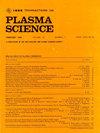用于电子束增材制造设备的可调四极管电子枪的静电设计
IF 1.3
4区 物理与天体物理
Q3 PHYSICS, FLUIDS & PLASMAS
引用次数: 0
摘要
电子枪作为发射高速电子的关键设备,决定着电子束增材制造(EBAM)中的电子束电流和质量。本文设计了一种带有控制电极的四极电子枪,以提高电子束的质量和可控性。通过参数模拟优化的控制电极可对电子束进行二次约束。这种限制旨在减小束斑尺寸和发射率,同时使束斑尺寸与电流脱钩。具体来说,最大电流可达 200 mA,而束腰半径仅为 1.09 mm。作为关键参数的归一化发射率为 1.536 倍 10^{-{7}}~text {m}\cdot \text {rad}$ 。此外,电子枪的稳定性分析还探讨了电极电位对其性能的影响。通过共同调节偏置电压和控制电压,电子束电流可以平稳地上升到 200 mA,同时保持束斑半径为 2 mm。这篇文章指出了四电极电子枪在精确控制方面的潜力,从而提高了高熔点合金增材制造工艺的质量和精度。本文章由计算机程序翻译,如有差异,请以英文原文为准。
Electrostatic Design of a Tunable Tetrode Electron Gun for Electron Beam Additive Manufacturing Device
The electron gun, as a critical device for emitting high-speed electrons, determines the electron beam current and quality in electron beam additive manufacturing (EBAM). In this article, a tetrode electron gun with a control electrode is designed to improve the quality and controllability of the electron beam. The control electrode, optimized by parametric simulation, provides secondary confinement of the electron beam. This confinement aims to reduce the beam spot size and emittance while decoupling spot size from the current. Specifically, the maximum attainable current reaches 200 mA, while the beam waist radius contracts to a mere 1.09 mm. The normalized emittance, a crucial parameter, measures at
$1.536\times 10^{-{7}}~\text {m}\cdot \text {rad}$
. Furthermore, stability analysis of the electron gun explores the influence of electrode potential on its performance. By co-regulating the bias voltage and the control voltage, the electron beam current can smoothly rise to 200 mA while maintaining the beam spot radius of 2 mm. This article indicates the tetrode electron gun’s potential for precise control, thereby improving the quality and precision of high melting point alloy additive manufacturing processes.
求助全文
通过发布文献求助,成功后即可免费获取论文全文。
去求助
来源期刊

IEEE Transactions on Plasma Science
物理-物理:流体与等离子体
CiteScore
3.00
自引率
20.00%
发文量
538
审稿时长
3.8 months
期刊介绍:
The scope covers all aspects of the theory and application of plasma science. It includes the following areas: magnetohydrodynamics; thermionics and plasma diodes; basic plasma phenomena; gaseous electronics; microwave/plasma interaction; electron, ion, and plasma sources; space plasmas; intense electron and ion beams; laser-plasma interactions; plasma diagnostics; plasma chemistry and processing; solid-state plasmas; plasma heating; plasma for controlled fusion research; high energy density plasmas; industrial/commercial applications of plasma physics; plasma waves and instabilities; and high power microwave and submillimeter wave generation.
 求助内容:
求助内容: 应助结果提醒方式:
应助结果提醒方式:


